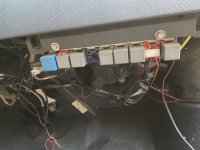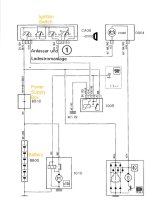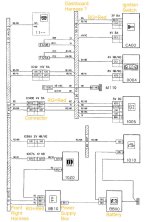I have just bought a 1996 Ducato camper with some electrical mess.
The radio is not working, I checked the ISO connectors and the battery voltage line stays 0V.
Apart from that, the signal line from the light switch which switches on the headlights is not
coming through to the dash display. Checked that line as well, no voltage.
That caused the instrument lights to stay off, so I bypassed that line.
Of course now the "lights on" indicator is always on. I prefer the original way though.
I have downloaded the service manual from this forum.
I can understand circuit diagrams, but it is vague where which component is located..
My questions:
- does anyone know which relays are shown on the photo and what function has the missing purple one?
- any suggestions on how I can identify these (or any) relay in the car?
- has anybody else had similar electrical problems and if os, what was the cause?
- has anyone some sort of map how the cable tree is laid out in the car and where each (or most) components/
connectors/relays are located?
Any help is appreciated
The radio is not working, I checked the ISO connectors and the battery voltage line stays 0V.
Apart from that, the signal line from the light switch which switches on the headlights is not
coming through to the dash display. Checked that line as well, no voltage.
That caused the instrument lights to stay off, so I bypassed that line.
Of course now the "lights on" indicator is always on. I prefer the original way though.
I have downloaded the service manual from this forum.
I can understand circuit diagrams, but it is vague where which component is located..
My questions:
- does anyone know which relays are shown on the photo and what function has the missing purple one?
- any suggestions on how I can identify these (or any) relay in the car?
- has anybody else had similar electrical problems and if os, what was the cause?
- has anyone some sort of map how the cable tree is laid out in the car and where each (or most) components/
connectors/relays are located?
Any help is appreciated





